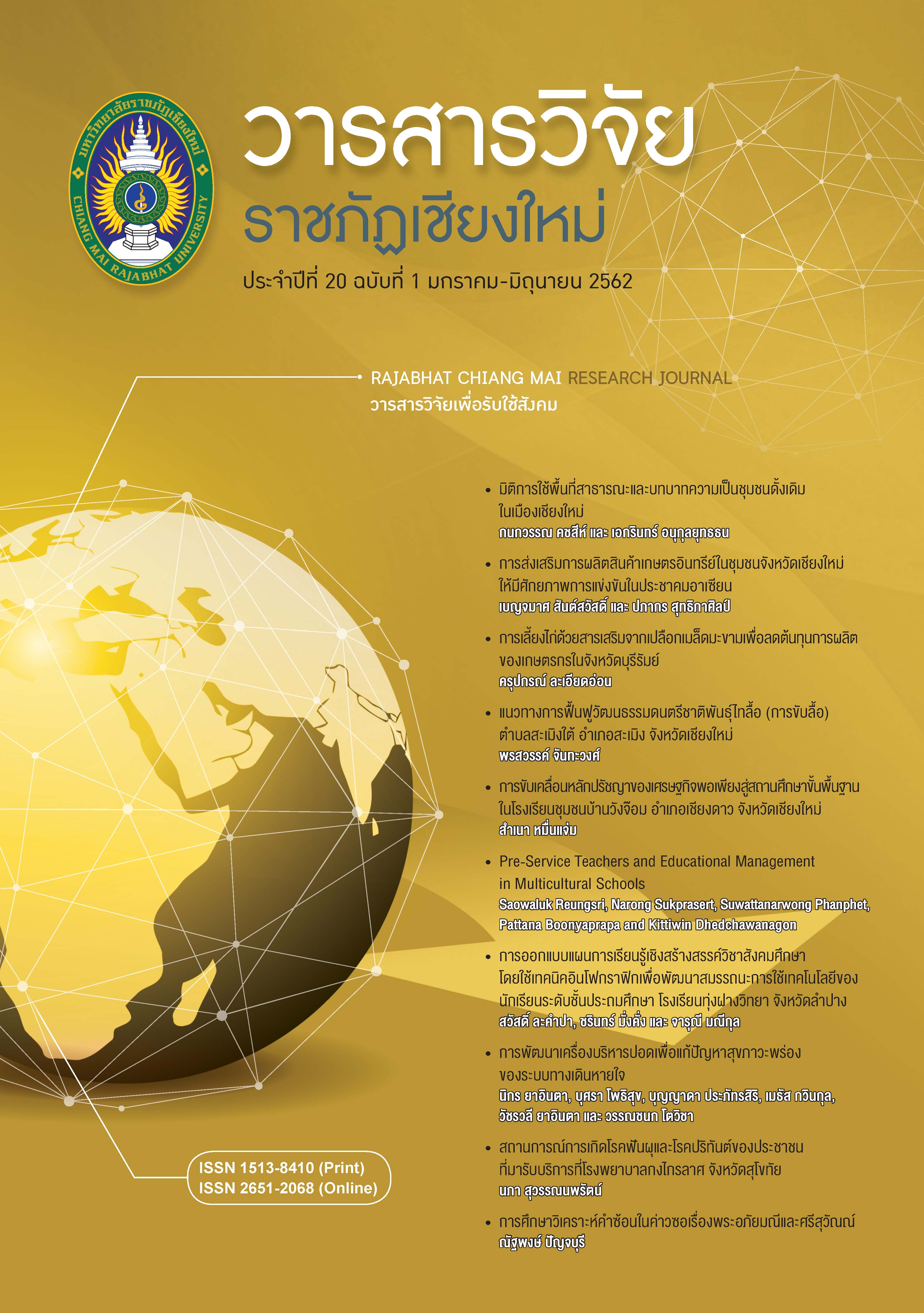Promoting the Production of Organic Products in Chiang Mai Province: the Potential Competition in ASEAN Community
DOI:
https://doi.org/10.14456/rcmrj.2019.181525Keywords:
Organic Agricultural Products, Agricultural Community, The Competitiveness in ASEAN CommunityAbstract
This research aims to study the potential of the agricultural communities and to propose the guideline of organic products in the communities of Chiang Mai in order to potentially compete in ASEAN Community based on the sufficiency economy philosophy. Studied on 207 agricultural communities in 25 districts of Chiang Mai province based on participatory research methodology (PAR) and analyze with SWOT Analysis (Strengths, Weaknesses, Opportunities and Threats). Discuss the results with percentage to reflect the problems and impacts that will be occur. The results showed that there are the potentially agricultural communities interested in are three groups, the fishing community of integrated local, the group of organic rice farmers and onion growers. Potential analysis found that strength is members with expertise in production, marketing, processing, and knowledge transfer. The weakness is unable to control the sales volume in each round and low bargaining power. The important opportunity is public and private sector support for regular knowledge and market support products, but obstacle is still pricing and a product volume high competitive. Therefore, it should promote the production system based on maintaining the natural balance and the use of wisdom, providing a better understanding of organic agriculture, developing organic communities, certifying the local organic products, promoting the development of organic agriculture to match the standards and requirements of the target country, and forming strong organic agriculture communities in Chiang Mai province. In order to control product quantity in each round and bargaining power.
Downloads
References
กองแผนงาน กรมปศุสัตว์. (2561). ยุทธศาสตร์การพัฒนาเกษตรอินทรีย์แห่งชาติ พ.ศ. 2560-2564. สืบค้นจาก https://planning.dld.go.th/th/index.php/th/plan-menu/574-2560-2564
ฐานเศรษฐกิจ. (2556). ดันเกษตรอินทรีย์ฮับอาเซียน ไทยชิงแชร์ตลาดโลก 1.8 ล้าน. สืบค้นจาก https://ditp.go.th/contents_attach/74347/74347.pdf
ณัฐดนัย ใหม่ซ้อน. (2555). พม่า-ลาว จ่อแซงหน้าไทยฐานผลิตเกษตรอินทรีย์อาเซียน. สืบค้นจาก https://www.food4change.in.th/ariticle/news-launcher/bad-news/541-2012-05-25-09-30-03.html
ดวงกมล บูรณสมภพ. (2557). กลยุทธ์ใหม่สำหรับการพัฒนาเกษตรอินทรีย์ของประเทศไทย. สืบค้นจาก https://th.aectourismthai.com/content1/2442
ธนสิทธิ์ เหล่าประเสริฐ. (2558). เล่าสองข้างทาง ดันมาตรฐานเกษตรอินทรีย์ไทยไต่ระดับสู่ตลาดโลก. สืบค้นจาก https://www.technologychaoban.com/news_detail.php?tnid=1942
นันทิยา หุตานุวัตร และณรงค์ หุตานุวัตร. (2545). SWOT การวางแผนกลยุทธ์ธุรกิจชุมชน. สถาบันชุมชนท้องถิ่นพัฒนา. คณะ
เกษตรศาสตร์ มหาวิทยาลัยอุบลราชธานี. สืบค้นจาก https://www.jit-jai-d.blogspot. com/2007/08/swot.html
มหาวิทยาลัยราชภัฏเชียงใหม่. (2558). การประชุมเชิงปฏิบัติการเพื่อทบทวนและวิเคราะห์สถานการณ์ และทิศทางการวิจัยของ
มหาวิทยาลัยราชภัฏเชียงใหม่ ต่อภาคการเกษตรจังหวัดเชียงใหม่ต่อการปรับตัวในประชาคมอาเซียน. วันที่ 9 กันยายน พ.ศ.2558
โรงแรมดิเอ็มเพรส, จังหวัดเชียงใหม่.
ศิรประภา ธงชัยสุริยา. (2558). การวิเคราะห์เปรียบเทียบต้นทุนและผลตอบแทนทางการเงินของการผลิตข้าวระหว่างวิธีการผลิตแบบ
ดั้งเดิม วิธีการผลิตแบบปลอดสารพิษ และวิธีการผลิตแบบเกษตรอินทรีย์ ในจังหวัดราชบุรี. การศึกษาค้นคว้าอิสระ เศรษฐศาสตร
มหาบัณฑิต (เศรษฐศาสตร์ธุรกิจ) บัณฑิตวิทยาลัย มหาวิทยาลัยเกษตรศาสตร์.
สุณัฐวีย์ น้อยโสภา. (2558). “เกษตรอินทรีย์” โอกาสการส่งออกของเกษตรกรไทยในตลาดโลก. วารสารวิชาการมหาวิทยาลัยธนบุรี,
9(18), 83-91.
David W. Crowder and John P. Reganold. (2015). Financial competitiveness of organic agriculture on a global scale.:
Retrieved From https://www.pnas.org/content/early/2015/05/27/1423674112
Porter, M. E. (1990). The_Competitive_Advantage_of_Nations. Harvard Business Review, 68(2), 73-91.
Downloads
Published
How to Cite
Issue
Section
License
1. Articles, information, content, images, etc published in the “Community and Social Development Journal” are copyrighted by the Community and Social Development Journal, Chiang Mai Rajabhat University. In order to properly distribute the articles through print and electronic media, the authors still hold the copyright for the published articles under the Creative Commons Attribution (CC BY) license, which allows the re-distribution of the articles in other sources. References must be made to the articles in the journal. The authors are responsible for requesting permission to reproduce copyrighted content from other sources.
2. The content of the articles appearing in the journal is the direct responsibility of the article authors. The editorial board of the journal does not necessarily agree with or share any responsibility.














